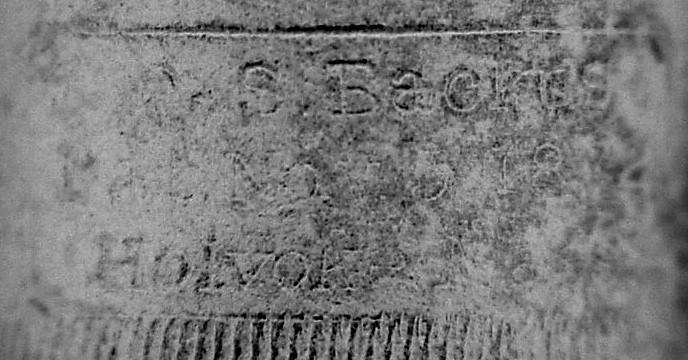That still makes me smile however many times I see it as a chapter heading.
As it's been a bit quiet on here lately I thought I'd follow up my discovery of the Amobrequin with another installment on my recent bulk purchase of assorted boring tools.
A pair of braces is always useful, even if they don't match, so I was pleased to find this old 'sixpenny' brace:

This one still has its locking screw to hold the bits in place, which is useful, as it can be hard to match the thread on something as old as this. They are very light weight, with a sweep of only about 7" and handy for small drills. No maker's name and impossible to date as the style kept going for so long.
My assortment also included this one:

which is by Melhuish, and marked STEEL 8"


- presumably to distinguish it from inferior iron braces. I think this might be it, in the 1921 catalogue:

but if so, it had got separated from its set of 24 bits. The button lifts a spring-loaded catch which should engage in a filed slot on the square tang. It doesn't fit any of the notches on the bits I tried, but that doesn't seem to be a problem. I think the handles are rosewood, and the head feels like it has ball bearings under it.
Now, that's all very well for ordinary hole drilling, but there comes a time in any woodworker's life when you need to drill round a corner. I don't know when that will happen to me, but when it does I shall be ready, and it's all thanks to the wonderfully named Quimby S Backus:
His name appears on this lovely bit of old iron:

as you can just about see here:

The lettering is a bit worn, but it clearly matches this one:

"Q S Backus
Pat. Nov 5 1872
Holyoke Mass."
which comes from this page at George's Basement where there is a huge amount of detailed information including patent dates. He makes it clear that the patent claim is for the chuck, not the swivel joint, and dates the tool to between 1876 and 1890. The full story is here and to me, the mixture of bright ideas, ambitious businessmen, patents and lawsuits seems ever so similar to the world of software and gadgets of today.
The chuck is actually really efficient, as it combines the tapered socket of the scotch brace with a pair of jaws that grip the round shaft of the bit:


- so I guess I will have to keep looking for a brace with the Quimby chuck. There is just about space left in the braces corner of the workshop:

but it's getting tight!
As it's been a bit quiet on here lately I thought I'd follow up my discovery of the Amobrequin with another installment on my recent bulk purchase of assorted boring tools.
A pair of braces is always useful, even if they don't match, so I was pleased to find this old 'sixpenny' brace:

This one still has its locking screw to hold the bits in place, which is useful, as it can be hard to match the thread on something as old as this. They are very light weight, with a sweep of only about 7" and handy for small drills. No maker's name and impossible to date as the style kept going for so long.
My assortment also included this one:

which is by Melhuish, and marked STEEL 8"


- presumably to distinguish it from inferior iron braces. I think this might be it, in the 1921 catalogue:

but if so, it had got separated from its set of 24 bits. The button lifts a spring-loaded catch which should engage in a filed slot on the square tang. It doesn't fit any of the notches on the bits I tried, but that doesn't seem to be a problem. I think the handles are rosewood, and the head feels like it has ball bearings under it.
Now, that's all very well for ordinary hole drilling, but there comes a time in any woodworker's life when you need to drill round a corner. I don't know when that will happen to me, but when it does I shall be ready, and it's all thanks to the wonderfully named Quimby S Backus:
His name appears on this lovely bit of old iron:

as you can just about see here:

The lettering is a bit worn, but it clearly matches this one:

"Q S Backus
Pat. Nov 5 1872
Holyoke Mass."
which comes from this page at George's Basement where there is a huge amount of detailed information including patent dates. He makes it clear that the patent claim is for the chuck, not the swivel joint, and dates the tool to between 1876 and 1890. The full story is here and to me, the mixture of bright ideas, ambitious businessmen, patents and lawsuits seems ever so similar to the world of software and gadgets of today.
The chuck is actually really efficient, as it combines the tapered socket of the scotch brace with a pair of jaws that grip the round shaft of the bit:


- so I guess I will have to keep looking for a brace with the Quimby chuck. There is just about space left in the braces corner of the workshop:

but it's getting tight!























































